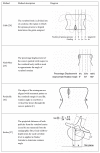Vertebral rotation measurement: a summary and comparison of common radiographic and CT methods
- PMID: 18976498
- PMCID: PMC2587463
- DOI: 10.1186/1748-7161-3-16
Vertebral rotation measurement: a summary and comparison of common radiographic and CT methods
Abstract
Current research has provided a more comprehensive understanding of Adolescent Idiopathic Scoliosis (AIS) as a three-dimensional spinal deformity, encompassing both lateral and rotational components. Apart from quantifying curve severity using the Cobb angle, vertebral rotation has become increasingly prominent in the study of scoliosis. It demonstrates significance in both preoperative and postoperative assessment, providing better appreciation of the impact of bracing or surgical interventions. In the past, the need for computer resources, digitizers and custom software limited studies of rotation to research performed after a patient left the scoliosis clinic. With advanced technology, however, rotation measurements are now more feasible. While numerous vertebral rotation measurement methods have been developed and tested, thorough comparisons of these are still relatively unexplored. This review discusses the advantages and disadvantages of six common measurement techniques based on technology most pertinent in clinical settings: radiography (Cobb, Nash-Moe, Perdriolle and Stokes' method) and computer tomography (CT) imaging (Aaro-Dahlborn and Ho's method). Better insight into the clinical suitability of rotation measurement methods currently available is presented, along with a discussion of critical concerns that should be addressed in future studies and development of new methods.
Figures
References
-
- Cole AA, Burwell RG, Webb JK. Lateral flexion induced axial rotation in adolescent idiopathic scoliosis (AIS) Studies in Health Technology and Informatics: Research into Spinal Deformities 1. 1997;37:93–96.
-
- Lafage V, Leborgne P, Mitulescu A, Dubousset J, Lavaste F, Skalli W. Comparison of mechanical behavior of normal and scoliotic vertebral segment: a preliminary numerical approach. Stud Health Technol Inform. 2002;88:340–344. - PubMed
-
- Farahpour N, Allard P, Labelle H, Rivard C, Duhaime M. Coupling mechanisms in the scoliotic spine. Studies in Health Technology and Informatics: Three-dimensional Analysis of Spinal Deformities. 1995;15:119–121.
-
- Beuerlein MJ, Raso VJ, Hill DL, Moreau MJ, Mahood JK. The relationship between axial rotation and lateral bending. Studies in Health Technology and Informatics: Research into Spinal Deformities 2. 1999;59:105–108.
-
- Heidari B, Fitzpatrick D, McCormack D, Synnott K. Correlation of an induced rotation model with the clinical categorization of scoliotic deformity – a possible platform for prediction of scoliosis progression. Stud Health Technol Inform. 2006;123:169–175. - PubMed
LinkOut - more resources
Full Text Sources
Other Literature Sources
Miscellaneous



